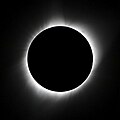| Total eclipse | |
| Gamma | −0.4947 |
|---|---|
| Magnitude | 1.0524 |
| Maximum eclipse | |
| Duration | 311 s (5 min 11 s) |
| Coordinates | 6°12′S114°12′E / 6.2°S 114.2°E |
| Max. width of band | 199 km (124 mi) |
| Times (UTC) | |
| Greatest eclipse | 4:43:33 |
| References | |
| Saros | 127 (56 of 82) |
| Catalog # (SE5000) | 9472 |
A total solar eclipse occurred at the Moon's ascending node of orbit on Saturday, June 11, 1983, [1] with a magnitude of 1.0524. A solar eclipse occurs when the Moon passes between Earth and the Sun, thereby totally or partly obscuring the image of the Sun for a viewer on Earth. A total solar eclipse occurs when the Moon's apparent diameter is larger than the Sun's, blocking all direct sunlight, turning day into darkness. Totality occurs in a narrow path across Earth's surface, with the partial solar eclipse visible over a surrounding region thousands of kilometres wide. Occurring about 2.1 days before perigee (on June 13, 1983, at 6:50 UTC), the Moon's apparent diameter was larger. [2]
Contents
- Restrictions of observation
- Observation
- Eclipse details
- Eclipse season
- Related eclipses
- Eclipses in 1983
- Metonic
- Tzolkinex
- Half-Saros
- Tritos
- Solar Saros 127
- Inex
- Triad
- Solar eclipses of 1982–1985
- Saros 127
- Metonic series
- Tritos series
- Inex series
- Notes
- References
The path of totality went through Christmas Islands, Indonesia, Papua New Guinea, and terminated in Vanuatu. The maximum eclipse occurred off the Indonesian island of Madura. Major Indonesian cities witnessed totality, including Yogyakarta, Semarang, Surabaya, and Makassar, in addition to Port Moresby in Papua New Guinea. A partial eclipse was visible for parts of Madagascar, Southeast Asia, Australia, and western Oceania.






































































































